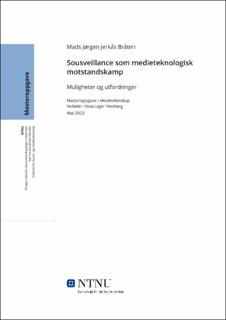| dc.contributor.advisor | Vestberg, Nina Lager | |
| dc.contributor.author | Bråten, Mads Jørgen Jerkås | |
| dc.date.accessioned | 2023-08-26T17:19:54Z | |
| dc.date.available | 2023-08-26T17:19:54Z | |
| dc.date.issued | 2023 | |
| dc.identifier | no.ntnu:inspera:137203035:31539726 | |
| dc.identifier.uri | https://hdl.handle.net/11250/3085889 | |
| dc.description.abstract | Steve Mann, en kanadisk professor i datateknologi med bakgrunn i medievitenskap, lanserte på 1990-tallet et begrep som skulle vise seg velegnet for å diskutere politivold rettet mot svarte personer og medieteknologiens rolle i dokumentasjon og formidling av slike hendelser. Dette begrepet, sousveillance, som er en inversjon av begrepet overvåking (surveillance), viser til observasjon eller dokumentasjon av handlingene til offentlige personer eller andre autoriteter som er involvert i en hendelse gjennom bruken av digital opptaksteknologi. Med utgangspunkt i en teoretisk drøfting av begrepet sousveillance har jeg i denne oppgaven analysert tre mye omtalte tilfeller av sousveillance gjennomført på ulike tidspunkter. De tre tilfellene er George Hollidays tilskuervideo av politivolden mot Rodney King (1991), Ramsey Ortas tilskuervideo av drapet på Eric Garner (2014) og Darnella Fraziers tilskuervideo av drapet på George Floyd (2020). Disse tilfellene fungerer som eksempler på sousveillance utført som motstand mot politivold. Denne masteroppgaven stiller dette spørsmålet som en overordnet problemstilling: Hvilken rolle kan digital teknologi, digital plattform for spredning av informasjon og den konteksten sousveillance finner sted i spille for sousveillance av politivold rettet mot svarte personer?
For å belyse denne problemstillingen og de mer spesifikke forskningsspørsmålene den rommer har jeg gjort rede for og drøftet sentrale teoretiske perspektiver og sentrale begreper knyttet til sousveillance. Denne gjennomgangen har dannet grunnlag for en nærmere analyse av de tre utvalgte tilskuervideoene av politivold rettet mot svarte personer i USA, samt av ulike konsekvenser av disse videoene. De tre utvalgte eksemplene på tilskuervideoer av politivold som inngår i oppgavens empiriske materiale ble beskrevet og analysert i tre separate kapitler, med fokus på opptaksteknologi, mediedistribusjon, og rollen som utøver av sousveillance. I tillegg ble det belyst i et eget kapittel hvordan den teknologiske utviklingen og digitale medieplattformer inngår i en bredere kontekst som kan påvirke mulighetene og begrensningene for systemisk forandring og motstand mot sosial undertrykkelse i USA. | |
| dc.description.abstract | Steve Mann, a Canadian professor of computer engineering with a background in media science, launched a concept in the 1990s that turned out to be well suited to discuss police violence directed towards black people, as well as the role of media technology in documenting and communicating such incidents. This concept, sousveillance, which is an inversion of surveillance, refers to the observation and documentation of the acts of public figures or other authorities involved in an incident by means of digital recording technology. Based on a theoretical discussion of the concept of sousveillance, I have in this master thesis analyzed three well-known cases of sousveillance that were carried out at various points of time. These cases exemplify sousveillance carried out as resistance against police violence. The three cases are George Holliday’s bystander video of the police violence against Rodney King (1991), Ramsey Orta’s bystander video of the killing of Eric Garner (2014), and Darnella Frazier’s bystander video of the murder of George Floyd (2020). This master thesis raises the following question as an overarching problem: Which role may digital technology, digital platform for distributing information, and the context in which sousveillance takes place play in sousveillance of police violence directed towards black people?
In order to respond to this question and the more specific research questions it involves, I have presented and discussed important theoretical perspectives and terms related to sousveillance. This theoretical clarification has formed the basis of an analysis of the three selected bystander videos of police violence directed towards black people in U.S.A., as well as of various consequences of these videos. The three selected examples of bystander videos included as empirical materials in this thesis were described and analyzed in three separate chapters, focusing on digital recording technology, distribution on media platforms, and the role of a sousveillant. Moreover, in a separate chapter, light was shed on how the technological development and digital media platforms are embedded in a broader context that may influence the possibilities and limitations of systemic change and resistance against social oppression in U.S.A. | |
| dc.language | nob | |
| dc.publisher | NTNU | |
| dc.title | Sousveillance som medieteknologisk motstandskamp: Muligheter og utfordringer | |
| dc.type | Master thesis | |
